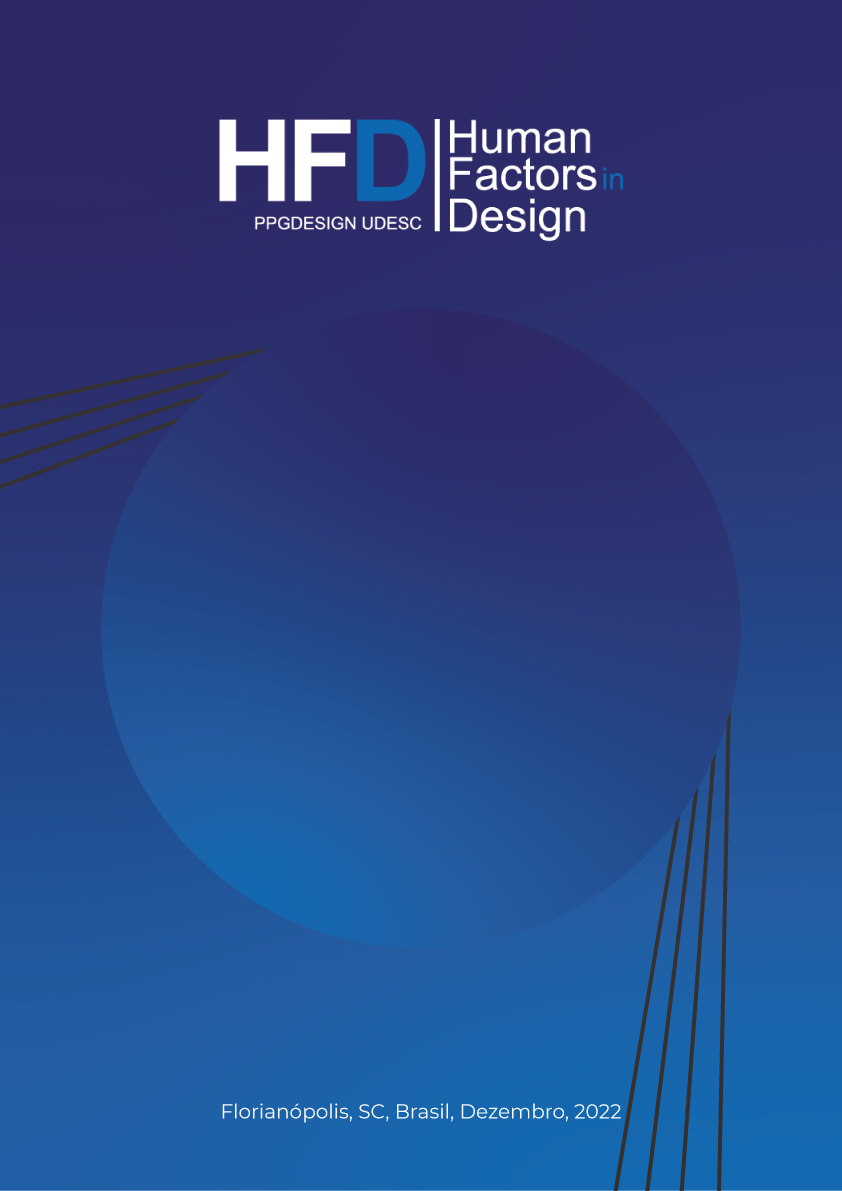UX Design and nomophobia: development of an assistant to facilitate the healthy use of smartphones
DOI:
https://doi.org/10.5965/2316796311222022155Keywords:
user experience, nomophobia, digital well-being, cell phone usage, usage timeAbstract
Based on the theme of excessive use of smartphones, this research addresses, from a bibliographic review, related topics to causes and consequences of an addictive smartphone usage; and the design relationship - User Experience (UX), in particular - as a mediator of this process of consumption. Subsequently, through the methodology of Double Diamond, a proposal was developed to increase the tool “Digital well-being”, from Android operating systems - aiming at a more gradual change in the consumption of smartphones. As a result, a usability test was obtained, indicating a satisfactory potential use of the developed proposal.
Downloads
References
ABREU, C. N; EISENSTEIN, E.; ESTEFENON, S. G. B.. Vivendo esse mundo digital. São Paulo: Artmed, 2013. Acesso em: 13/11/2021.
ANDROID. Bem-estar digital. Disponível em: <https://www.android.com/intl/pt-BR_br/digital-wellbeing/>. Acesso em: 17/11/2021.
ANTONA B. et al. Symptoms associated with reading from a smartphonein conditions of light and dark, Applied Ergonomics; Madrid, Espanha; v. 68, p.12-17, 2018.
APP ANIE. The State of Mobile 2019, 2019. Disponível em: <https://www.appannie.com/en/go/state-of-mobile-2019> Acesso em: 29/09/2021.
APP ANIE. The State of Mobile 2021, 2021. Disponível em: <https://www.appannie.com/en/go/state-of-mobile-2021> Acesso em: 29/09/2021.
ARTY, David. O que é Design System?, 2020. Disponível em: <https://www.chiefofdesign.com.br/design-system/>. Acesso em: 14/11/2021.
CAMBRIDGE Dictionary. Cambridge Dictionary declares ‘nomophobia’ the People’s Word of 2018, 2018. Disponível em: <http://services.cambridge.org/about-us/news/cambridge-dictionary-declaresnomophobia-peoples-word-2018/> Acesso em: 28/09/2021.
DESIGN COUNCIL. The Double diamond: 15 years on, 2021. Disponível em: <https://www.designcouncil.org.uk/news-opinion/double-diamond-15-years>,
FGV. Brasil tem 424 milhões de dispositivos digitais em uso, revela a 31ª Pesquisa Anual do FGVcia, 2020. Disponível em: <https://portal.fgv.br/noticias/brasil-tem-424-milhoes-dispositivos-digitais-uso-revela31a-pesquisa-anual-fgvcia> Acesso em: 29/09/2021.
FIGMA. Figma Official Website. Disponível em: <https://www.figma.com/>. Acesso em: 17/11/2021.
FRANÇA, Tradzio. Brasileiros dormem menos do que o recomendado; saiba como melhorar a qualidade de seu sono, 2021. Disponível em: <http://www.tribunadonorte.com.br/noticia/brasileiros-dormem-menos-do-que-orecomendado-saiba-como-melhorar-a-qualidade-de-seu-sono/501665> Acesso em: 11/05/2021.
GABRIELLA, Lopes. Exposing social media and the attention economy. Disponível em: <https://www.gabriella.work/work/vortex>. Acesso em: 24/09/2021.
GRILO, André. Experiência do Usuário em interfaces digitais: Compreendendo o design nas tecnologias da informação. Natal: SEDIS-UFRN, 2019.
GUTERRES J.L.; Schmitt F.S.; Oliveira L.C.; Simon C.D.S; Lopes A.R. Principais queixas relacionadas ao uso excessivo de dispositivos móveis. Pleiade 2017. p. 39-45. Disponível em: <https://pleiade.uniamerica.br/index.php/pleiade/article/view/333/416 >. Acesso em: 29/09/2021.
KING, A. L. S.; NARDI, A. E.; CARDOSO, A. (Ed.). Nomofobia: dependência do computador, internet, redes sociais? Dependência do celular? v. 1. São Paulo: Atheneu, 2014.
KLEMENT, A. Replacing The User Story With The Job Story. Jobs To Be Done, 2013. Disponível em: <https://jtbd.info/replacing-the-user-story-with-the-job-story-af7cdee10c27>. Acesso em: 17/11/2021.
MARIE CLARIE, Redação. "Nomofobia": medo de ficar sem o celular se tornou a palavra do ano, 2018. Disponível em: <https://revistamarieclaire.globo.com/Noticias/noticia/2018/12/nomofobia-medo-deficar-sem-o-celular-se-tornou-palavra-do-ano.html> Acesso em: 28/09/2021.
MAZE. Official Maze Website. Disponível em: <https://maze.co/>. Acesso em: 17/11/2021.
O SUL, Redação. O uso de celular em excesso aumenta a depressão e a ansiedade, 2017. Disponível em: <https://www.osul.com.br/o-uso-de-celular-em-excesso-aumenta-depressao-eansiedade/> Acesso em: 11/05/2021.
PERRIN, Andrew. 10 facts about smartphones as the iPhone turns 10, 2017. Disponível em: <https://www.pewresearch.org/fact-tank/2017/06/28/10-facts-about-smartphones/>. Acesso em: 17/11/2021.
RIBEIRO, Felipe. Mais da metade dos internautas brasileiros não fica um dia sem celular, 2019. Disponível em: <https://canaltech.com.br/internet/ibope-mais-da-metade-dos-internautas-brasileirosnao-fica-um-dia-sem-celular-133457/> Acesso em: 11/05/2021.
SILVA R. S.; Soares Bílio E.; Thiara dos Reis Pinto K.; Souza Silva L.; Carvalho de Figueiredo R. O uso de smartphone e seu impacto no cotidiano da vida dos acadêmicos. REVISTA CEREUS, v. 12, n. 3, p. 53-67.
SOUZA, A. F. de; MIRANDA, A. C. de O. Os problemas causados pelo uso excessivo de smartphones. 2018. Disponível em: <http://prpi.ifce.edu.br/nl/_lib/file/doc4147-Trabalho/ARTIGO%20terminado.pdf>. Acesso em: 17/11/2021.
STATISTA. Mobile operating systems' market share worldwide from January 2012 to June 2021, 2021. Disponível em: <https://www.statista.com/statistics/272698/global-market-share-held-by-mobileoperating-systems-since-2009/> Acesso em: 17/11/2021.
STOCK, Adriana. Celular antes de dormir afeta sono, hormônios e desenvolvimento infantil, 2018. Disponível em: <https://www.bbc.com/portuguese/geral-42603165>. Acesso em: 17/11/2021.
TEIXEIRA, Fabrício. Introdução e Boas Práticas em UX Design. São Paulo: Editora Casa do Código, 2014.
URSULA, Davies, WILSON, Kelly. Design methods for developing services. 1.ed. Londres: Design Council, 2005.
VITRINE DO VAREJO. smartphones seguem em alta em 2020, 2020. Disponível em: <https://vitrinedovarejo.com/smartphones-seguem-em-alta-em-2020/> Acesso em: 29/09/2021.
Downloads
Published
How to Cite
Issue
Section
License
Copyright (c) 2022 Human Factors in Design

This work is licensed under a Creative Commons Attribution 4.0 International License.
Os artigos publicados pela revista são de uso gratuito, destinados a aplicações acadêmicas e não comerciais. Os direitos autorais são todos cedidos à revista. Os artigos cujos autores são identificados representam a expressão do ponto de vista de seus autores e não a posição oficial da revista Human Factors Design. O (s) autor (es) se compromete a sempre que publicar material referente ao artigo publicado na Revista Human Factors Design mencionar a referida publicação da seguinte forma:
Este artigo foi públicado originalmente pela Revista Human Factors Design em seu volume (colocar o volume), número (colocar o número) no ano de (colocar o ano) e pode ser acessado em: https://periodicos.udesc.br/index.php/hfd/index


